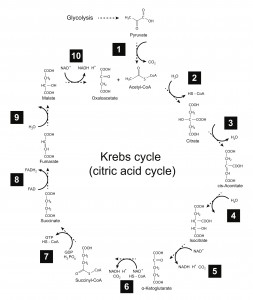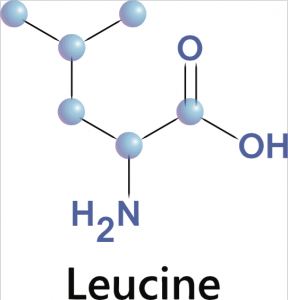Leucine: ‘THE’ Growth Switch!
Leucine is the most important of the BCAAs. When it comes to signaling muscle building (protein synthesis), Leucine is King ...

Leucine is the most important of the BCAAs. When it comes to signaling muscle building (protein synthesis), Leucine is King ...
Question: “Will taking simple carbs after a workout negate the effect of growth hormone production from your workout and kill ...
Bodybuilders and other fitness-minded folk are for the most part considered to be a healthy bunch. Well balanced nutrition, regular ...
Question: “Let’s say we have your average trainee who works out four of five times a week, working each bodypart ...
From boosting testosterone production & supporting lean muscle growth, to optimizing joint health & immune function, getting enough of this ...
Looking for lazer focus and unabated energy during tough workouts? Tyrosine could be the superamino you need to swoop in ...
Muscles store carbohydrates exclusively as glycogen, which is basically a long chain of glucose molecules linked together. The level of ...
Omega-3s are one of the fats that actually have gotten a lot of good press. In this case it’s actually ...
In today’s society, emphasis is placed on work and productivity over anything else. This could mean sacrificing quality of nutrition ...
What you need to know in review: Carbs have a direct effect on the release of insulin Insulin is considered ...
Key Point Summary: – There are 5 ‘levels’, or stages, you must implement IN ORDER to optimize fat loss. – ...
In terms of exercise performance and recovery, few amino acids get the notable mention that BCAA’s do. While glutamine is the most abundant single amino acid in muscle tissue, BCAA’s are the most abundant type of amino acid in muscle tissue.
 BCAAs are proteinogenic amino acids (amino acids that are precursors to proteins) so they are important as building blocks for protein and muscle. there are three BCAAs: leucine, isoleucine and valine. All three of these are also classified as essential amino acids, meaning that we must get them from our diet, the body cannot synthesize them on its own.
BCAAs are proteinogenic amino acids (amino acids that are precursors to proteins) so they are important as building blocks for protein and muscle. there are three BCAAs: leucine, isoleucine and valine. All three of these are also classified as essential amino acids, meaning that we must get them from our diet, the body cannot synthesize them on its own.
BCAAs account for roughly 40% of your dietary essential amino acid requirement. They have been found to reduce muscle soreness from intense muscle-damaging exercise and improve training motivation, especially when fatigued. BCAA’s can signal protein synthesis, improve insulin signaling, recovery and prevent muscle tissue breakdown.
BCAA’s are unique in that they are anabolic and anti-catabolic, and increase both cortisol and insulin. This makes them great for training, but outside of training they are conditionally beneficial. The easiest way to think of it is that BCAA’s taken in a low calorie meal , and pre training, are anti-catabolic. While BCAA’s taken in the presence of high protein and carb meals are anabolic.
Normally when you train your body increases protein degrading compounds to break down BCAA’s for fuel, but when you take them through diet before training you actually inhibit this catabolic response on a transcription level, turning of the manufacturing of the catabolic compounds. The same applies for periods between meals or when using a lower carbohydrate diet. It is suggested that muscle is designed to burn BCAAs for energy during exercise, making BCAA intake and muscle reserves essential for performance.
 BCAA’s are both muscle sparing and performance enhancing because they feed the citric acid cycle. As you train your body oxidizes BCAA’s either from dietary intake or your own muscle tissues.
BCAA’s are both muscle sparing and performance enhancing because they feed the citric acid cycle. As you train your body oxidizes BCAA’s either from dietary intake or your own muscle tissues.
Branched-chain alpha-keto acid dehydrogenase complex (BCKDH) breaks down the BCAAs into Acetyl-CoA which can be converted into acetyl-CoA or succinyl-CoA, each of which can enter your ATP producing citric acid cycle.
Your citric acid cycle is the energy source of choice during high intensity training like weight training or HIIT. It provides fast energy to help you recover between sets. It runs off the breakdown of amino acids or glucose.
Because BCAA’s are highly glycogenic, they can be converted to glucose increasing the glycemic load and insulin load of meal. This can be of value in a post training meals, but the first meal of the day is probably not a good place to take high doses of BCAAs if your goal is fat loss. The exceptions would be this is also your pre-training meal, or you are having a low carb/ calorie breakfast like and need to supplement some BCAA’s for the anti-catabolic effects. When dieting down, using supplemental BCAA’s as a low calorie snack between meals with some greens is a great way to combat catabolism and keep calories low and fat burning going. But over 10 grams will likely shut of fat burning in this case.
Studies show young adults who consume more BCAA’s have more lean body mass and People who consume a threshold dose of essential amino acids that contain BCAAs with every meal have less visceral belly fat and more muscle mass.
Adequate BCAA intake can improve glucose uptake and insulin sensitivity. BCAAs are can actually stimulate insulin dependent transport of amino acids into the cells.
BCAA’s do occur naturally in food protein sources, with the highest concentrations in chicken, beef, salmon, eggs, and whey protein. Supplemental free form BCAA’s that are unbound are the most effective at inducing the anti-catabolic and anabolic response. When in the free form, BCAA’s require no digestion and bypass the liver and gut tissue and go directly to the bloodstream and elicit their effect. Any protein sources that requires digestion will lose a portion of its amino acid content during the digestion process. So just because X protein source is made of certain amino acid amounts does not mean that amount actually reaches your plasma. You would need at least 2-3x as many dietary BCAA’s to equal plasma level of free form BCAA’s.
Taking BCAA’s in their free form also allows for a spike of BCAA’s over other amino acids in the plasma. This means the signaling effects of the BCAAs will be higher. Additionally the absorption time is very fast for free form amino acids, whereas whey protein will be about 2x slower and food based 4+ x slower digesting.
 For an average sized adult male 6g of BCAAs seems to be the threshold for muscle sparing benefits during exercise or when on lower calorie diets. Doses of 20g throughout training elicit a more anabolic effect for those looking to use BCAA’s for muscle building. Higher dosages of BCAA’s do require that you have adequate amounts of B-vitamins, especially B6. I suggest a good B complex supplement for anyone on a high protein diet so that they can make the best use of all the amino acids they take in. Additionally higher dosages of BCAAs for anabolism work best with insulin, suggesting that high dosing BCAA’s without using any carbohydrates will drastically decrease their anabolic potential. So if you want to high dose BCAA’s for muscle growth, do it when you are also having carbohydrates intra/ post workout.
For an average sized adult male 6g of BCAAs seems to be the threshold for muscle sparing benefits during exercise or when on lower calorie diets. Doses of 20g throughout training elicit a more anabolic effect for those looking to use BCAA’s for muscle building. Higher dosages of BCAA’s do require that you have adequate amounts of B-vitamins, especially B6. I suggest a good B complex supplement for anyone on a high protein diet so that they can make the best use of all the amino acids they take in. Additionally higher dosages of BCAAs for anabolism work best with insulin, suggesting that high dosing BCAA’s without using any carbohydrates will drastically decrease their anabolic potential. So if you want to high dose BCAA’s for muscle growth, do it when you are also having carbohydrates intra/ post workout.
The most talked about BCAA is leucine because it has a strong effect on promoting protein synthesis through the mTOR pathway. Leucine also play key roles in the uptake of other amino acids and increased fat burning. Leucine is likely the most important of the amino acids for building muscle, and deserves an article of its own.